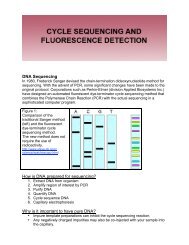DNA Cloning
DNA Cloning
DNA Cloning
Create successful ePaper yourself
Turn your PDF publications into a flip-book with our unique Google optimized e-Paper software.
Page 19<br />
Biol 312 L Molecular Biology Lab<br />
which to use the recombinant vector in additional <strong>DNA</strong> manipulations, <strong>DNA</strong><br />
sequencing, or driving gene expression.<br />
In the next part of this cloning experiment, you will set up ligation reactions with<br />
the restriction enzyme-digested <strong>DNA</strong> fragments. In general, ligations should have<br />
a several fold excess of insert <strong>DNA</strong> over vector <strong>DNA</strong>. The ligation you perform<br />
will likely result in several different types of molecules, and hopefully a few will<br />
contain a single copy of the gene in a covalently closed plasmid. Because we<br />
have the blue-white screen and a drug selection marker we should be able to<br />
identify clones containing our gene of interest.<br />
Before setting up a ligation, we must heat inactivate the restriction enzymes in<br />
the reaction. Otherwise they will continue to cut the <strong>DNA</strong> we are trying to join.<br />
IMPORTANT POINT:<br />
Enzymes are the “tool kit” of the molecular biologist. You must put away the<br />
“saw” (restriction enzymes that cut <strong>DNA</strong>) before you use the “hammer and nails”<br />
(ligase to join <strong>DNA</strong> fragments). Always anticipate the next step in the process!<br />
BRIEF GLOSSARY<br />
Biotechnology Applying biology in the real world by the specific manipulation of<br />
living organisms, especially at the genetic level, to produce potentially beneficial<br />
products.<br />
<strong>Cloning</strong> When a population of cells is prepared by growth from a single cell, all<br />
the cells in the population will be genetically identical. Such a population is called<br />
clonal. The process of creating a clonal population is called “cloning”. Identical<br />
copies of a specific <strong>DNA</strong> sequence, or gene, can be accomplished following<br />
mitotic division of a transformed host cell.<br />
Genetic Engineering The manipulation of an organism’s genetic material (<strong>DNA</strong>)<br />
by introducing or eliminating specific genes.<br />
Gene Regulation Gene expression in all organisms is carefully regulated to<br />
allow for differing conditions and to prevent wasteful overproduction of unneeded<br />
proteins. The genes involved in the transport and breakdown of food are good<br />
examples of highly regulated genes. For example, the milk sugar lactose can be<br />
used as a source of energy and carbon by bacteria. The bacterial enzymes that<br />
are needed to break down or digest lactose for food are not expressed in the<br />
absence of lactose but are expressed when lactose is present in the<br />
environment.<br />
Induction The lac operon controls expression of the lactose utilizing genes, and<br />
this operon has been genetically engineered to provide a screen for a <strong>DNA</strong><br />
insert. Gene expression is induced when X-gal, an analog of lactose, is present<br />
in the medium and the protein �-galactosidase is then produced.



